Racial policy of Nazi Germany

The racial policy of Nazi Germany was a set of policies and laws implemented in Nazi Germany under the dictatorship of Adolf Hitler, based on a specific racist doctrine asserting the superiority of the Aryan race, which claimed scientific legitimacy. This was combined with a eugenics programme that aimed for racial hygiene by compulsory sterilization and extermination of those who they saw as Untermenschen ("sub-humans"), which culminated in the Holocaust.
Nazi policies labeled centuries-long residents in German territory who were not ethnic Germans such as Jews (understood in Nazi racial theory as a "Semitic" people of Levantine origins), Roma (also known as Gypsies, an "Indo-Aryan" people of Indian subcontinent origins), along with the vast majority of Slavs (mainly ethnic Poles, Serbs, Russians etc.), and most non-Europeans as inferior non-Aryan subhumans (i.e. non-Nordics, under the Nazi appropriation of the term "Aryan") in a racial hierarchy that placed the Herrenvolk ("master race") of the Volksgemeinschaft ("people's community") at the top.[1][2][3][4][5][6][7]
Basis of Nazi policies and constitution of the Aryan Master Race[]
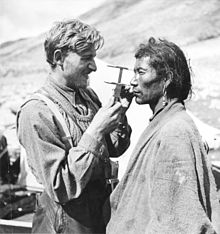
The Aryan Master Race conceived by Hitler and the Nazis graded humans on a scale of pure Aryans to non-Aryans (who were viewed as subhumans).[8] At the top of the scale of pure Aryans were Germans and other Germanic peoples, including the Dutch, Scandinavians, and the English.[8] Latins were held to be somewhat inferior, but were tolerated; the Italians and the French were thought to have a suitable admixture of Germanic blood.[9]
The feeling that Germans were the Aryan Herrenvolk (Aryan master race) was widely spread among the German public through Nazi propaganda and among Nazi officials throughout the ranks, in particular when the Reichskommissar of Ukraine Erich Koch said:
We are a master race, which must remember that the lowliest German worker is racially and biologically a thousand times more valuable than the population here.
— Erich Koch, 5 March 1943[10]
The Nazis considered the Slavs as Non-Aryan Untermenschen ("sub-humans") who were to be enslaved and exterminated by Germans.[4] Slavic nations such as the Ukrainians, Czechs, Slovaks, Bulgarians and Croats who collaborated with Nazi Germany were still being perceived as not racially "pure" enough to reach the status of Germanic peoples, yet they were eventually considered ethnically better than the rest of the Slavs, mostly due to pseudoscientific theories about these nations having a considerable admixture of Germanic blood.[11] In countries where these people lived, there were according to Nazis small groups of non-Slavic German descendants. These people underwent a "racial selection" process to determine whether or not they were "racially valuable", if the individual passed they would be re-Germanised and forcefully taken from their families in order to be raised as Germans.[12][13][14] This secret plan Generalplan Ost ("Master Plan East") aimed at expulsion, enslavement and extermination of most Slavic people. Nazi policy towards them changed during World War II as a pragmatic means to resolve military manpower shortages: they were allowed, with certain restrictions, to serve in the Waffen-SS, in spite of being considered subhumans.[14] Nazi propaganda portrayed people in Eastern Europe with an Asiatic appearance to be the result of intermingling between the native Slavic populations and Asiatic or Mongolian races as sub-humans dominated by the Jews with the help of Bolshevism.[15] At the bottom of the racial scale of non-Aryans were Jews, ethnic Poles, ethnic Serbs and other Slavic people, Romani, and black people.[16] The Nazis originally sought to rid the German state of Jews and Romani by means of deportation (and later extermination), while blacks were to be segregated and eventually eliminated through compulsory sterilization.[16][17]
Volkisch theorists believed that Germany's Teutonic ancestors had spread out from Germany throughout Europe.[18] Of the Germanic tribes that spread through Europe, the theorists identified that the Burgundians, Franks, and Western Goths joined with the Gauls to make France; the Lombards moved south and joined with the Italians; the Jutes made Denmark; the Angles and Saxons made England; the Flemings made Belgium; and other tribes made the Netherlands.[18]
Nazi racial beliefs of the superiority of an Aryan master race arose from earlier proponents of a supremacist conception of race such as the French novelist and diplomat Arthur de Gobineau, who published a four-volume work titled An Essay on the Inequality of the Human Races (translated into German in 1897).[19] Gobineau proposed that the Aryan race was superior, and urged the preservation of its cultural and racial purity.[20] Gobineau later came to use and reserve the term Aryan only for the "German race" and described the Aryans as 'la race germanique'.[21] By doing so he presented a racist theory in which Aryans–that is Germans–were all that was positive.[22] Houston Stewart Chamberlain's work The Foundations of the Nineteenth Century (1900), one of the first to combine Social Darwinism with antisemitism, describes history as a struggle for survival between the Germanic peoples and the Jews, whom he characterized as an inferior and dangerous group.[23] The two-volume book Foundations of Human Hereditary Teaching and Racial Hygiene (1920–21) by Eugen Fischer, Erwin Baur, and Fritz Lenz, used pseudoscientific studies to conclude that the Germans were superior to the Jews intellectually and physically, and recommended eugenics as a solution.[24] Madison Grant's work The Passing of the Great Race (1916) advocated Nordicism and proposed using a eugenic program to preserve the Nordic race. After reading the book, Hitler called it "my Bible".[25]
Racist author and Nordic supremacist[26] Hans F. K. Günther, who influenced Nazi ideology, wrote in his "Race Lore of German People" (Rassenkunde des deutschen Volkes) about the danger of "Slavic blood of Eastern race" mixing with the German[27] and combined virulent nationalism with Antisemitism.[28] Günther became an epitome of corrupt and politicized pseudo-science in post-war Germany.[29] Among the topics of his research were attempts to prove that Jewish people had an unpleasant "hereditary smell".[30] While one of the most prominent Nazi writers, Günther still was not considered the most "cutting edge" by Nazis.[31]
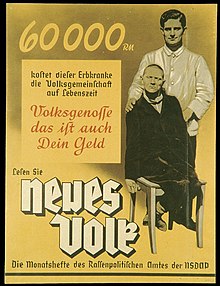
The July 1933 Law for the Prevention of Hereditarily Diseased Offspring – written by Ernst Rüdin and other theorists of "racial hygiene" – established "Genetic Health Courts" which decided on compulsory sterilization of "any person suffering from a hereditary disease." These included, for the Nazis, those suffering from "Congenital Mental Deficiency", schizophrenia, "Manic-Depressive Insanity", "Hereditary Epilepsy", "Hereditary Chorea" (Huntington's), Hereditary Blindness, Hereditary Deafness, "any severe hereditary deformity", as well as "any person suffering from severe alcoholism".[32] Further modifications of the law enforced sterilization of the "Rhineland bastards" (children of mixed German and African parentage).
The Nazi Party wanted to increase birthrates of those who were classified as racially elite. When the Party gained power in 1933, one of their first actions was to pass the Law for the Encouragement of Marriage. This law stated that all newly married couples of the Aryan race could receive a government loan. This loan was not simply paid back, rather a portion of it would be forgiven after the birth of each child. The purpose of this law was very clear and simple: to encourage newlyweds to have as many children as they could, so that the Aryan population would grow.[33]
Racial policies regarding the Jews, 1933–1940[]
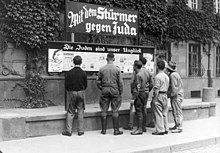
There were approximately 525,000 Jewish people living in Germany in 1933 (0.75% of the total German population).[34] Discrimination against Jews began immediately after the national seizure of power in 1933.[35] The Nazi Party used populist antisemitic views to gain votes. Using the "stab-in-the-back legend", they blamed poverty, the Hyperinflation in the Weimar Republic, unemployment, and the loss of World War I and surrender by the "November Criminals" all on the Jews and "cultural Bolsheviks", the latter considered to be in a conspiracy with the Jews. German woes were attributed to the effects of the Treaty of Versailles. In 1933, persecution of the Jews became active Nazi policy. This was at first hindered by the lack of agreement on who qualified as a Jew as opposed to an Aryan; this caused legislators to balk at an antisemitic law for its ill-defined terms.[36] Bernhard Lösener described it "total chaos", with local authorities regarding anything from full Jewish background to 1⁄8 Jewish blood as defining a Jew; Achim Gercke urged 1⁄16 Jewish blood.[37] Those of mixed descent (Mischlinge) were especially problematic in their eyes.[38] The first antisemitic law was promulgated with no clear definition of a Jew.[39] Finally, the criterion was set at three or four Jewish grandparents; two or one rendered a person a Mischling.[40]
On April 1, 1933, the Nazi boycott of Jewish businesses was observed throughout Germany. Only six days later, the Law for the Restoration of the Professional Civil Service was passed, banning Jews from government jobs. It is notable that the proponents of this law, and the several thousand more that were to follow, most frequently explained them as necessary to prevent the infiltration of damaging, "alien-type" (Artfremd) hereditary traits into the German national or racial community (Volksgemeinschaft).[41] These laws meant that Jews were now indirectly and directly dissuaded or banned from privileged and superior positions reserved for "Aryan Germans". From then on, Jews were forced to work in more menial positions, becoming second-class citizens or to the point that they were "illegally residing" in Nazi Germany.
In the early years of Nazi rule, there were efforts to secure the elimination of Jews by expulsion; later, a more explicit commitment was made to extermination. On August 25, 1933, the Nazis signed the Haavara Agreement with Zionists to allow German Jews to emigrate to Palestine in exchange for a portion of their economic assets. The agreement offered a way to leave an increasingly hostile environment in Nazi Germany; by 1939, 60,000 German Jews (about 10% of the Jewish population) had emigrated there. Thereafter, Nazi policy eventually changed to one of total extermination. Nazi doctrine culminated in the Holocaust, or so-called "Final Solution", which was made official at the January 1942 Wannsee Conference.
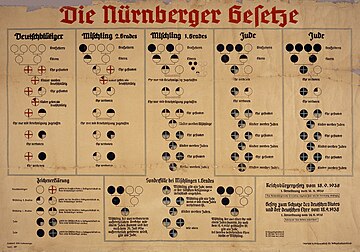
Nuremberg Laws[]
This section needs additional citations for verification. (April 2021) |
Between 1935 and 1936, persecution of the Jews increased apace while the process of "Gleichschaltung" (lit.: "standardisation", the process by which the Nazis achieved complete control over German society) was implemented. In May 1935, Jews were forbidden to join the Wehrmacht (the armed forces), and in the summer of the same year, anti-semitic propaganda appeared in shops and restaurants. The Nuremberg Laws were passed around the time of the great Nazi rallies at Nuremberg; on September 15, 1935, the "Law for the Protection of German Blood and Honor" was passed. At first this criminalised sexual relations and marriage only between Germans and Jews, but later the law was extended to "Gypsies, Negroes and their bastard offspring"; it became punishable by law as Rassenschande or racial pollution.[42][43] After this, the "Reich Citizenship Law" was passed, and was reinforced in November by a decree; it included only people of "German or related blood", which meant that all Jews were stripped of their citizenship and their official title became "subjects of the state". This meant that they were deprived of basic citizens' rights, e.g. the right to vote.[44] This removal of citizens' rights was instrumental in the process of anti-semitic persecution: the process of denaturalization allowed the Nazis to exclude—de jure—Jewish people from the "Volksgemeinschaft" ("national community"), thus granting judicial legitimacy to their persecution and opening the way to harsher laws and, eventually, extermination of the Jews. Philosopher Hannah Arendt pointed out this important judicial aspect of the Holocaust in The Origins of Totalitarianism (1951), where she demonstrated that to violate human rights, Nazi Germany first deprived human beings of their citizenship. Arendt underlined that in the Declaration of the Rights of Man and of the Citizen, citizens' rights actually preceded human rights, as the latter needed the protection of a determinate state to be actually respected.
The drafting of the Nuremberg Laws has often been attributed to Hans Globke. Globke co-authored several aspects of the laws, such as the ordinance which legally required Jews with non-Jewish names to take on the additional first names Israel or Sara, along with the official legal commentary on the Reich Citizenship Law.[44]
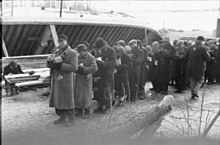
In 1936, Jews were banned from all professional jobs, effectively preventing them from having any influence in education, politics, higher education, and industry. There was now nothing to stop the anti-Jewish actions that spread across the German economy.
Between 1937 and 1938, new laws were implemented, and the segregation of Jews from the "German Aryan" population was completed. In particular, Jews were punished financially for being Jewish.
From March 1, 1938, government contracts could not be awarded to Jewish businesses. On September 30, "Aryan" doctors could only treat "Aryan" patients. Provision of medical care to Jews was already hampered because Jews were banned from being doctors.
On August 17, Jews with first names of non-Jewish origin were legally required to add "Israel" (males) or "Sara" (females) to their names, and a large letter "J" was to be printed on their passports on October 5.[44] On November 15, Jewish children were banned from going to state-run schools. By April 1939, nearly all Jewish companies had either collapsed under financial pressure and declining profits, or been persuaded to sell out to the government, further reducing their rights as human beings; they were, in many ways, effectively separated from the German populace.
The increasingly totalitarian regime that Hitler imposed on Germany allowed him to control the actions of the military. On November 7, 1938, a young Polish Jew named Herschel Grynszpan attacked and shot German diplomat Ernst vom Rath in the German embassy in Paris. Grynszpan's family, together with more than 12,000 Polish-born Jews, had been expelled by the Nazi government from Germany to Poland in the so-called "Polenaktion" on October 28, 1938. Joseph Goebbels ordered retaliation. On the night of November 9, the SS and SA conducted "the Night of Broken Glass" ("Kristallnacht"), in which at least 91 Jews were killed and a further 30,000 arrested and incarcerated in Nazi concentration camps. After the start of the war, and the conquest of numerous European countries, the Jewish population was put into ghettos, from which they were shipped to death camps where they were murdered.
Jewish responses to the Nuremberg Laws[]
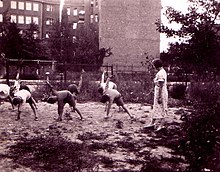
After the promulgation of the Nuremberg Laws, the Reichsvertretung der Deutschen Juden (Representation of the German Jews) announced the following:
The Laws decided upon by the Reichstag in Nuremberg have come as the heaviest of blows for the Jews in Germany. But they must create a basis on which a tolerable relationship becomes possible between the German and the Jewish people. The "Reichsvertretung der Deutschen Juden" is willing to contribute to this end with all its powers. A precondition for such a tolerable relationship is the hope that the Jews and Jewish communities of Germany will be enabled to keep a moral and economic means of existence by the halting of defamation and boycott.
The organization of the life of the Jews in Germany requires governmental recognition of an autonomous Jewish leadership. The Reichsvertretung der Juden in Deutschland is the agency competent to undertake this.
The most urgent tasks for the "Reichsvertretung", which it will press energetically and with full commitment, following the avenues it has previously taken, are:
Our own Jewish educational system must serve to prepare the youth to be upright Jews, secure in their faith, who will draw the strength to face the onerous demands which life will make on them from conscious solidarity with the Jewish community, from work for the Jewish present and faith in the Jewish future. In addition to transmitting knowledge, the Jewish schools must also serve in the systematic preparation for future occupations. With regard to preparation for emigration, particularly to Palestine, emphasis will be placed on guidance toward manual work and the study of the Hebrew language. The education and vocational training of girls must be directed to preparing them to carry out their responsibilities as upholders of the family and mothers of the next generation.[45]
Sinti and Roma[]
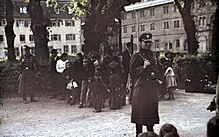
Nazi Germany began persecution of the Romani as early as 1936 when they began to transfer the people to municipal internment camps on the outskirts of cities, a prelude to the deportation of 23,000 Gypsies to concentration camps. "Pure-blooded" Gypsies were considered by the Nazis to be Aryan.[46] Roughly ten percent of Gypsies were considered to be racially pure.[47]
Heinrich Himmler suggested creating a "Gypsy Law" to separate Gypsies from the German people:
The aim of measures taken by the State to defend the homogeneity of the German nation must be the physical separation of Gypsydom from the German nation, the prevention of miscegenation, and finally, the regulation of the way of life of pure and part-Gypsies. The necessary legal foundation can only be created through a Gypsy Law, which prevents further intermingling of blood, and which regulates all the most pressing questions which go together with the existences of Gypsies in the living space of the German nation.[48]
However, although many laws during Nazi Germany persecuted the Gypsies, a specific "Gypsy Law", although talked about often, was never enacted by the Nazis.[49]
Afro-Germans[]

In Mein Kampf, Hitler described children resulting from marriages to African occupation soldiers as a contamination of the Aryan race "by Negro blood on the Rhine in the heart of Europe."[50] He thought that "Jews were responsible for bringing Negroes into the Rhineland, with the ultimate idea of bastardizing the white race which they hate and thus lowering its cultural and political level so that the Jew might dominate."[51] He also implied that this was a plot on the part of the French, saying the population of France was being increasingly "negrified".[52][53]

The number of black people in Germany when the Nazis came to power is variously estimated at 5,000 to 25,000.[52][54] According to the United States Holocaust Memorial Museum, Washington, D.C., "The fate of black people from 1933 to 1945 in Nazi Germany and in German-occupied territories ranged from isolation to persecution, sterilization, medical experimentation, incarceration, brutality, and murder. However, there was no systematic program for their elimination as there was for Jews and other groups."[52]
Prior to Hitler coming to power, black entertainers were popular in Germany, but the Nazis banned jazz as "corrupt negro music".[52]
Of particular concern to the Nazi scientist Eugen Fischer were the "Rhineland Bastards": mixed-race offspring of Senegalese soldiers who had been stationed in the Rhineland as part of the French army of occupation. He believed that these people should be sterilized in order to protect the racial purity of the German population. At least 400 mixed-race children were forcibly sterilized in the Rhineland by 1938. This order only applied in the Rhineland. Other African Germans were unaffected. Despite this policy, there was never any systematic attempt to eliminate the black population in Germany, though some blacks were used in medical experiments, and others mysteriously disappeared.[52]
According to Susan Samples, the Nazis went to great lengths to conceal their sterilization and abortion program in the Rhineland.[55] Hans Massaquoi describes his experience as a half-African in Hamburg, unaware of the Rhineland sterilizations until long after the war.[56] Samples also points to the paradoxical fact that African-Germans actually had a better chance of surviving the war than the average German. They were excluded from military activity because of their non-Aryan status, but were not considered a threat and so were unlikely to be incarcerated. Samples and Massaquoi also note that African-Germans were not subjected to the segregation they would have experienced in the United States, nor excluded from facilities such as expensive hotels. However, they both state that downed black American pilots were more likely to become victims of violence and murder from German citizens than white pilots.[52]
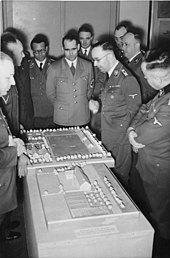
Policies regarding Poles, Russians and other Slavs[]
As early as 1925, Hitler suggested in Mein Kampf that the German people needed Lebensraum ("living space") to achieve German expansion eastwards (Drang nach Osten) at the expense of the "inferior Slavs". Hitler believed that "the organization of a Russian state formation was not the result of the political abilities of the Slavs in Russia, but only a wonderful example of the state-forming efficacity of the German element in an inferior race."[57]
After the invasion of the Soviet Union, Hitler expressed his future plans for the Slavs:
As for the ridiculous hundred million Slavs, we will mould the best of them as we see fit, and we will isolate the rest of them in their own pig-styes; and anyone who talks about cherishing the local inhabitants and civilising them, goes straight off into a concentration camp![58]
Nazi ideology viewed the Slavic peoples as non-Aryan Untermenschen ("sub-humans"), who were targeted for enslavement, expulsion and extermination.[11] The racial status of Slavs during the Third Reich was inconsistent over time.[59] Hitler viewed the Slavs as "a mass of born slaves who feel the need of a master".[60] Nazi propaganda portrayed the Germanic peoples as "heroes" in contrast to the Jewish and Slavic "sub-humans".[61] Nazi propaganda depicted Eastern Europe as racially mixed "Asiatic" that was dominated by the Jews with the aid of Bolshevism.[15] The Nazis considered some people in Eastern Europe to be suitable for Germanization (they were presumed to be of German descent); if they were considered racially valuable they were to be re-Germanized and forcefully taken from their families to Germany and raised as Germans.[12]
The final version of Generalplan Ost, essentially a grand plan for ethnic cleansing, was divided into two parts: the Kleine Planung ("Small Plan"), which covered actions which were to be taken during the war, and the Grosse Planung ("Big Plan"), which covered actions to be undertaken after the war was won (to be carried into effect gradually over a period of 25–30 years). The Small Plan was to be put into practice as the Germans conquered the areas to the east of their pre-war borders. The individual stages of this plan would then be worked out in greater detail. In this way, the plan for Poland was drawn up at the end of November 1939.
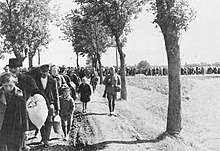
The plan envisaged removal of the majority of the population of conquered counties, with very small and varied percentages of the various conquered nations undergoing Germanisation, expulsion into the depths of Russia, and other fates, the net effect of which would be to ensure that the conquered territories would be Germanized.[11] Himmler declared during the Germanization process that no drop of German blood would be lost or left behind to mingle with any "alien races".[62] The Wehrbauer ("soldier-peasants") would settle in a fortified line to prevent civilization arising beyond and threatening Germany.[63]
The Nazis issued the Polish decrees on 8 March 1940 which regulated the working and living conditions of Polish laborers (Zivilarbeiter) used during World War II in Germany. The decrees set out that any Pole "who has sexual relations with a German man or woman, or approaches them in any other improper manner, will be punished by death."[64] The Gestapo were extremely vigilant about sexual relations between Germans and Poles and pursued any case relentlessly where this was suspected.[65] There were similar regulations used against the other ethnic groups brought in from Eastern Europe, including the death penalty for sexual relations with a German person.[65] During the war, hundreds of Polish and Russian men were executed for their relations with German women.[66][67]
Heinrich Himmler, in his secret memorandum "Reflections on the Treatment of Peoples of Alien Races in the East" dated 25 May 1940, expressed his own thoughts and the future plans for the populations in the East.[68] Himmler stated that it was in the German interest to discover as many ethnic groups in the East and splinter them as much as possible, find and select racially valuable children to be sent to Germany to assimilate them and restrict non-Germans in the General Government and conquered territories to four-grade elementary school which would only teach them how to write their own name, to count up to 500 and to obey Germans.[68] Himmler believed the Germanization process in Eastern Europe would be complete when "in the East dwell only men with truly German, Germanic blood".[69]
Other "non-Aryans"[]

Though the laws were primarily directed against Jews,[70] other "non-Aryan" people were subject to the laws, and to other legislation concerned with racial hygiene. The definition of "Aryan" was never fully defined as the term was too imprecise and ambiguous, it was attempted to be clarified over time in a number of judicial and executive decisions. Jews were by definition non-Aryan, because of their Semitic origins. Outside of Europe in North Africa, according to Alfred Rosenberg's racial theories (The Myth of the Twentieth Century), some of the Berbers, particularly the Kabyles, were to be classified as Aryans.[71] The Nazis portrayed Swedes, the Afrikaaners – who are white European descendants of Dutch-speaking Boers in South Africa – and higher-degree Northern/Western Europeans of South America (mainly from Uruguay, Brazil and Argentina) as ideal "Aryans" along with the German-speaking peoples of Greater Germany and Switzerland (the country was neutral during the war). The Roma (Gypsies), who, while considered originally Aryan, were deemed a threat to the Aryan race because of their racial mingling.[72]
Although Turkic peoples had been perceived initially as "racially inferior" by the Nazis, this attitude changed in autumn 1941, when, in view of the difficulties faced in their invasion of the Soviet Union, the Nazis attempted to harness the anti-Russian sentiment of Turkic peoples in the Soviet Union for political gain. The first Turkestan Legion was mobilized in May 1942. The East Battalions contained between 275,000 and 350,000 "Muslim and Caucasian" volunteers and conscripts.[73]
Norwegians[]
In Norway, the Nazis favored and promoted children between Germans and Norwegians, in an attempt to raise the birth rate of Nordic Aryans. Around 10,000–12,000 war children (Krigsbarn) were born from these unions during the war. Some of them were separated from their mothers and cared for in so-called "Lebensborn" clinics ("Fountain of Life" clinics).[74][75]
Han Chinese and Japanese[]


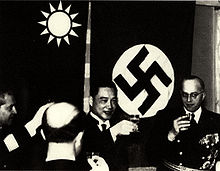

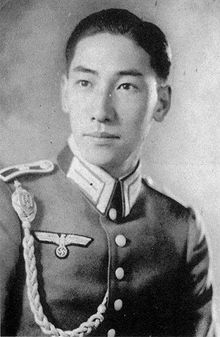
Despite substantial racial and cultural differences, Adolf Hitler and the official National Socialist German Workers Party policy described the Han Chinese and Japanese as "Aryans of the East", "Honorary Aryans" and the "Herrenvolk of the Orient" (i.e. the "Master race of the Orient").[76][77]
In Mein Kampf (1925-26), Hitler wrote "ancient civilization of Japan actually became fossilized and petrified", and added "the real foundations of contemporary Japanese life are [their adaptation of] the enormous scientific and technical achievements of Europe and America, that is to say, of Aryan peoples."[78] 1945, Adolf Hitler said:
Pride in one's own race, and that does not imply contempt for other races, is also a normal and healthy sentiment. I have never regarded the Chinese or the Japanese as being inferior to ourselves. They belong to ancient civilizations, and I admit freely that their past history is superior to our own. They have the right to be proud of their past, just as we have the right to be proud of the civilization to which we belong. Indeed, I believe the more steadfast the Chinese and the Japanese remain in their pride of race, the easier I shall find it to get on with them.[79]
Adolf Hitler had allowed Han Chinese and Japanese soldiers to study in Nazi German military academies and serve in the Nazi German Wehrmacht as part of their combat training. Since 1926, Germany had supported the Republic of China militarily and industrially. Germany had also sent advisers such as Alexander von Falkenhausen and Hans von Seeckt to assist the Chinese, most notably in the Chinese Civil War and China's anti-communist campaigns. Max Bauer was sent to China and served as one of Chiang Kai-shek's advisers. Around this time, Hsiang-hsi Kung, the Republic of China Minister of Finance, visited Nazi Germany and was warmly welcomed by Adolf Hitler on June 13, 1937. During this meeting, Adolf Hitler, Hermann Göring and Hjalmar Schacht bestowed upon Hsiang-hsi Kung an honorary doctorate degree, and attempted to open China's market to German exports. And in order to attract more Han Chinese students to study in Germany, Adolf Hitler, Hermann Göring and Hjalmar Schacht earmarked for 100,000 reichsmarks for Han Chinese students studying in the universities and military academies of Nazi Germany after they persuaded a German industrialist to set aside the money for that purpose. Additionally, Hsiang-hsi Kung, in favor of commercial credits, politely refused a generous international loan offer by Adolf Hitler.[80] The most famous of these Han Chinese Nazi soldiers was Chiang Wei-kuo, the son of Republic of China President Chiang Kai-shek, who studied military strategy and tactics at a Nazi German Kriegsschule in Munich, and subsequently achieved the rank of lieutenant and served as a soldier in the Wehrmacht on active combat duty in Europe until his return to the Republic of China during the later years of World War II.[81][82][83][77]
Adolf Hitler had supported the Empire of Japan as early as 1904, when during the Russo-Japanese War it had defeated the Russians, which he considered a defeat for Austrian Slavism.[84][85] He made a number of other statements expressing his respect and admiration for the Japanese in his book Mein Kampf.[86][87]
Although of a different evolutionary race, the Han Chinese and Imperial Japanese were considered by Nazi ideologists such as Himmler as having sufficiently superior qualities as did German-Nordic blood to warrant an alliance. Himmler, who possessed a great interest in, and was influenced by, the anthropology, philosophies and pantheistic religions of East Asia, mentioned how his friend Hiroshi Ōshima, the Japanese Ambassador to Germany, believed that the noble castes in Japan, the Daimyō and the Samurai, were descended from gods of celestial origin, which was similar to Himmler's own belief that "the Nordic race did not evolve, but came directly down from heaven to settle on the Atlantic continent."[88]
Karl Haushofer, a German general, geographer, and geopolitician, whose ideas may have influenced the development of Hitler's expansionist strategies, saw Japan as the brother nation to Germany. In 1908, he was sent by the German Army "to Tokyo to study the Japanese Army and to advise it as an artillery instructor. The assignment changed the course of his life and marked the beginning of his love affair with the orient. During the next four years he traveled extensively in East Asia, adding Korean, Japanese, and Mandarin to his repertoire of Russian, French, and English languages. Karl Haushofer had been a devout student of Schopenhauer, and during his stay in the Far East he was introduced to Oriental esoteric teachings."[89] It was based on such teachings that he came to make similar bestowals of his own upon the Japanese people, calling them the "Aryans of the East", and even the "Herrenvolk of the Orient" (i.e. the "Master race of the Orient").[76]
Initially on official Nazi documents the Japanese were technically "subject" to Germany's racial laws since the Nazi legal clauses were not altered on German documents until Nazi German Foreign Minister Konstantin von Neurath issued an official exemption in 1933. But in everyday practice Adolf Hitler and his Nazi government exempted both Han Chinese and Japanese from these racial laws due their recognition as "Aryans of the East." In cases of dispute or intermarriage, both Chinese and Japanese were exempted from the Nazi racial laws and treated in a lenient manner compared to "non-Aryans" who had not been granted "Aryan" status. Hitler's government began enacting the laws after taking power in 1933, and the Japanese government initially protested several racial incidents involving Japanese or Japanese-Germans that year which were then resolved by the Nazi high command by treating their Japanese allies leniently. But after the Republic of China (Taiwan) switched sides and joined an alliance with the United States and declared war on Nazi Germany Sino-German cooperation collapsed resulting in Chinese nationals facing prosecution in Germany. Influential Nazi anti-Semite Johann von Leers favored excluding Japanese and Chinese from the racial laws due both to the alleged Aryan racial link with Han Chinese and Japanese and to improve diplomatic relations with both China and Japan. The Foreign Ministry agreed with von Leers and sought several times between 1934 and 1937 to change the laws, but other government agencies, including the Racial Policy Office, opposed the change.[90]
In October 1933 a formal statement by Nazi German Foreign Minister Konstantin von Neurath officially stated that both Han Chinese and Japanese were exempt from Nazi racial laws. In April 1935 an additional decree stated that racial discrimination cases involving “Aryans of the East” that might jeopardize German diplomatic relations—i.e., Chinese and Japanese—would be dealt with individually. The Nazi German government often exempted most German-Japanese issues in order to avoid a repeat of the 1933 controversies, and in 1934 it prohibited the German press from discussing the race laws when Japanese and Chinese were involved.[90]
Germanization between 1939 and 1945[]
Nazi policy stressed the superiority of the Nordic race, a sub-race of the white European population defined by the measurement of the size and proportions of the human body models of racial difference.[91] From 1940 the Nazis in General Government (occupied Poland) divided the population into different groups.[62] Each group had different rights, food rations, allowed strips in the cities, separated residential areas, special schooling systems, public transportation and restricted restaurants. Later adapted in all Nazi-occupied countries by 1942, the Germanization program used the racial caste system of reserving certain rights to one group and barred privileges to another. Ethnic Poles were believed by Hitler to be "biologically inferior race" that could never be educated or elevated through Germanization.[92] In 1940, Hitler approved of a plan regarding the Germanization of the Protectorate of Bohemia and Moravia, he estimated around half of the Czech population were suitable for Germanization but made clear that the "mongoloid" types and Czech intelligentsia were not allowed to be Germanized.[93]
During the occupation of Poland, the Nazis kept an eye out for children with Nordic racial characteristics. Those classified as "racially valuable" were sent from to the German Reich to be adopted and raised as Germans, while those who failed the tests would be used as slaves or murdered in medical experiments.[94]
Nordicist anthropometrics was used to "improve" the racial make-up of the Germanized section of the population, by absorbing individuals into the German population who were deemed suitably Nordic.[11]
Germanization also affected the Sorbs, the minority Slav community living in Saxony and Brandenburg, whose Slavic culture and language was suppressed to absorb them into German identity.[95] Tens of thousands suffered internment and imprisonment as well, to become lesser-known victims of Nazi racial laws.[96] Similarly, the Nazis considered the people living in the Goralenvolk area to be descended from ethnic Germans and were therefore classified as Aryans.[97]
See also[]
|
|
References[]
Notes
- ^ Operation Barbarossa: Ideology and Ethics against Human Dignity, by André Mineau, (Rodopi, 2004) page 180
- ^ The Czechs under Nazi Rule: The Failure of National Resistance, 1939–1942, Vojtěch Mastný, Columbia University Press[page needed]
- ^ Hitler's Home Front: Wurttemberg Under the Nazis, Jill Stephenson p. 135, Other non-'Aryans' included Slavs, Blacks and Roma .
- ^ Jump up to: a b The Politics of Fertility in Twentieth-Century Berlin - Page 118 Annette F. Timm - 2010 The Nazis' singleminded desire to "purify" the German race through the elimination of non-Aryans (particularly Jews, Gypsies, and Slavs)
- ^ The Holocaust and History The Known, the Unknown, the Disputed, and the Reexamined Edited by Michael Berenbaum and Abraham J. Peck, Indiana University Press page 59 "Pseudoracial policy of Third Reich(...)Gypsies, Slavs, blacks, Mischlinge, and Jews are not Aryans."
- ^ Modern Genocide: The Definitive Resource and Document Collection Paul R. Bartrop, Steven Leonard Jacobs page 1160, "This strict dualism between the "racially pure" Aryans and all others—especially Jews and Slavs—led in Nazism to the radical outlawing of all "non-Aryans" and to their enslavement and attempted annihilation"
- ^ World Fascism: A Historical Encyclopedia, Volume 1 Cyprian Blamires page 63 "the "racially pure" Aryans and all others—especially Jews and Slavs— led in Nazism to the radical outlawing of all "non-Aryans" and to their enslavement and attempted annihilation
- ^ Jump up to: a b Davies 2006, p. 167.
- ^ Davies 2006, p. 44.
- ^ Shirer 1960, p. 939.
- ^ Jump up to: a b c d Gumkowski, Janusz; Leszczynski, Kazimierz; Robert, Edward (translator) (1961). Hitler's Plans for Eastern Europe. Poland Under Nazi Occupation (First ed.). Polonia Pub. House. p. 219. ASIN B0006BXJZ6. Archived from the original (Paperback) on 9 April 2011. Retrieved 14 March 2014.
- ^ Jump up to: a b Bendersky, Joseph W. (11 July 2013). A Concise History of Nazi Germany. Rowman & Littlefield. p. 180. ISBN 978-1-4422-2270-0.
- ^ Gellately, Robert; Stoltzfus, Nathan (2001). Social Outsiders in Nazi Germany. Princeton University Press. p. 106. ISBN 978-0-691-08684-2.
- ^ Jump up to: a b Davies 2006, pp. 167, 209.
- ^ Jump up to: a b Longerich 2010, p. 241.
- ^ Jump up to: a b Simone Gigliotti, Berel Lang. The Holocaust: A Reader. Malden, Massachusetts, USA; Oxford, England, UK; Carlton, Victoria, Australia: Blackwell Publishing, 2005. Pp. 14.
- ^ "Hitler's Home Front: Wurttemberg Under the Nazis" Jill Stephenson page 113 " Other non-'Aryans' included Slavs, Blacks and Roma and Sinti (Romanies)"
- ^ Jump up to: a b George Victor. Hitler: The Pathology of Evil. Washington, DC, USA: Potomac Books, Inc, 2007. Pp. 117.
- ^ Aly 2014, p. 154.
- ^ Evans, Richard J. (2003). The Coming of the Third Reich, p.33
- ^ The Cambridge Companion to Tacitus Page 294 A. J. Woodman - 2009 The white race was defined as beautiful, honourable and destined to rule; as 'cette illustre famille humaine, la plus noble'.74 Originally a linguistic term synonymous with Indo-European,7S 'Aryan' became, not least because of the Essai, the designation of a race, which Gobineau specified as 'la race germanique'
- ^ So that the reader not be left in ignorance as to who the Aryans are, Gobineau stated: "La race germanique était pourvue de toute l'énergie de la variété ariane." We see, then, that Gobineau presents a racist theory in which the Aryans, or Germans, are all that is good Comparative literature by American Comparative Literature Association.; Modern Language Association of America. Comparative Literature Section.; University of Oregon. 1967, page 342
- ^ Evans, Richard J. (2003). The Coming of the Third Reich. New York, p.33-34
- ^ Aly 2014, p. 157.
- ^ Kühl 2002, p. 85.
- ^ Kohn, Marek (1996). The Race Gallery: The Return of Racial Science. Vintage. p. 48.
- ^ Hund, Wulf D.; Koller, Christian; and Zimmerman, Moshe (2011) Racisms Made in Germany LT Verlag. p.19 ISBN 9783643901255
- ^ Wegner, Gregory (2002) Anti-Semitism and Schooling Under the Third Reich. New York: Routledge. p.14 ISBN 9780815339434
- ^ Race, Color, Identity: Rethinking Discourses about "Jews" in the Twenty-first Century Efraim Sicher Berghahn Books, 15 May 2013
- ^ Oisteanu, Andrei (2009) Inventing the Jew: Antisemitic Stereotypes in Romanian and Other Central-East European Cultures. Lincoln, Nebraska: University of Nebraska Press. p.68 ISBN 9780803220980
- ^ Steinweis, Alan E. (2006) Studying the Jew: Scholarly Antisemitism in Nazi Germany. Cambridge, Massachusetts: Harvard University Press, p.26 ISBN 9780674022058
- ^ The law for the prevention of hereditarily diseased offspring. (Approved translation of the "Gesetz zur Verhütung erbkranken Nachwuchses"). Enacted on July 14th, 1933. Published by Reichsausschuss für Volksgesundheitsdienst. (Berlin: Reichsdruckerei, 1935). (Official translation of the law into English)
- ^ Maynes, Mary Jo., and Ann Beth. Waltner (2012) "Powers of Life and Death": The Family: A World History Oxford: Oxford University Press. p.103
- ^ "Jewish Population of Europe in 1933: Population Data by Country". encyclopedia.ushmm.org.
- ^ Shirer 1960, p. 203.
- ^ Koonz 2003, p. 170.
- ^ Koonz 2003, p. 171.
- ^ Koonz 2003, p. 174.
- ^ Koonz 2003, p. 184.
- ^ Koonz 2003, p. 187.
- ^ Ehrenreich 2007, pp. 1, 165–167.
- ^ S. H. Milton (2001). ""Gypsies" as social outsiders in Nazi Germany". In Robert Gellately and Nathan Stoltzfus (ed.). Social Outsiders in Nazi Germany. Princeton University Press. pp. 216, 231. ISBN 9780691086842.
- ^ Burleigh & Wippermann 1991, p. 49.
- ^ Jump up to: a b c Wistrich, Robert (2002). Who's Who in Nazi Germany. Routledge. ISBN 0-415-26038-8.
- ^ Yahil, Leni (1998). The Holocaust: The Fate of European Jewry, 1932-1945. Oxford University Press. p. 79. ISBN 0195045238.
- ^ Lewy 2000, p. 139.
- ^ Lewy 2000, pp. 49, 137.
- ^ Burleigh & Wippermann 1991, p. 121.
- ^ Lewy 2000, p. 86.
- ^ Mein Kampf, volume 1, chapter XIII.
- ^ Mein Kampf, volume 1, chapter XI.
- ^ Jump up to: a b c d e f "The forgotten black victims of Nazi Germany". Voice Online. GV Media Group Ltd. 16 February 2009. Archived from the original on 23 February 2009. Retrieved 9 March 2014.
- ^ Adolf Hitler, Mein Kampf, Vol. II, chapter XIII
- ^ "Black people in Nazi Germany". Anne Frank Guide. Anne Frank House. 28 September 2018.
- ^ Samples, S., "African Germans in the Third Reich", The African German Experience, Carol Aisha Blackshire-Belay ed.
- ^ Massaquoi, Hans J., Destined to Witness: Growing Up Black in Nazi Germany, Harper Perennial, 2001. He mistakenly states that they were later murdered in the Holocaust, p.2
- ^ Adolf Hitler, Mein Kampf, 1925[page needed]
- ^ H. R. Trevor-Roper; Gerhard L. Weinberg (18 October 2013). Hitler's Table Talk 1941-1944: Secret Conversations. Enigma Books. p. 466. ISBN 978-1-936274-93-2.
- ^ Ehrenreich 2007, p. 10.
- ^ David Welch (17 June 2013). Hitler: Profile of a Dictator. Routledge. p. 74. ISBN 978-1-136-40156-5.
- ^ Longerich 2010, p. 83.
- ^ Jump up to: a b Overy 2004, p. 543.
- ^ Robert Cecil, The Myth of the Master Race: Alfred Rosenberg and Nazi Ideology p190 ISBN 0-396-06577-5
- ^ Robert Gellately (8 March 2001). Backing Hitler: Consent and Coercion in Nazi Germany. Oxford University Press. p. 155. ISBN 978-0-19-160452-2.
- ^ Jump up to: a b Robert Gellately (1990). The Gestapo and German Society: Enforcing Racial Policy, 1933–1945. Clarendon Press. p. 224. ISBN 978-0-19-820297-4.
- ^ Nazi Ideology and the Holocaust. United States Holocaust Memorial Museum. January 2007. p. 58. ISBN 978-0-89604-712-9.
- ^ Diemut Majer, "Non-Germans" Under the Third Reich, p. 855
- ^ Jump up to: a b Himmler, Heinrich (25 May 1940). Reflections on the Treatment of Peoples of Alien Races in the East. Trials of War Criminals Before the Nuernberg Military Tribunals Under Control Council Law No. 10. US Government Printing Office, District of Columbia. pp. 147–150, Vol. 13.
- ^ Mark Mazower, Hitler's Empire: How the Nazis Ruled Europe, p.181
- ^ "The Concept "Jew" in Nazi German "Race" Legislation". Archived from the original on 11 May 2008. Retrieved 21 June 2014.
- ^ (a)"The Berbers, among whom even today one finds light skins and blue eyes, do not go back to the Vandal invasions of the fifth century A.D., but to the prehistoric Atlantic Nordic human wave. The Kabyle huntsmen, for example, are to no small degree still wholly Nordic (thus the blond Berbers in the region of Constantine form 10 % of the population; at Djebel Sheshor they are even more numerous).", Alfred Rosenberg, The Myth of the Twentieth Century, 1930; (b) "Among the Berbers a Nordic strain shows itself clearly", Hans F.K. Günther, The racial elements of European History, 1927
- ^ "Gypsies in the Holocaust".
- ^ Audrey L. Alstadt (2013). "The Azerbaijani Turks: Power and Identity under Russian Rule". p. 187. ISBN 9780817991838
- ^ BBC, 4 February 2003, Norway's Nazi legacy (in English)
- ^ Le Figaro, 8 March 2007, Les enfants des nazis traînent la Norvège devant les tribunaux (Children of Nazis bring Norway before the Courts) (in French)
- ^ Jump up to: a b The Spear of Destiny: The occult power behind the spear which pierced the side of Christ and how Hitler inverted the force in a bid to conquer the world, Trevor Ravenscroft, p. 229, June 1982.
- ^ Jump up to: a b "How Did East Asians Become Yellow? - Leiden University". Universiteitleiden.nl. 2016-11-23. Retrieved 2019-09-16.
- ^ Adolf Hitler, Mein Kampf (1925, 1926). Chapter XI: Race and People. James Murphy translation, Hurst and Blackett, LTD., 1939.
- ^ Hitler, Adolf; Genoud, François ed. (1961) The Testament of Adolf Hitler: The Hitler-Bormann Documents, February-April 1945 Translated by Col. R. H. Stevens. London: Cassell. p.53
- ^ "Business: Kung's Credits" TIME Magazine
- ^ "That One Time the Nazis Helped China Fight Japan - War Is Boring". Medium. 2014-01-03. Retrieved 2019-09-16.
- ^ Sunday, September 8, 2019 (2019-09-08). "An Unexpected Partnership in WW2: Nazi Germany and the Republic of China". Warhistoryonline.com. Retrieved 2019-09-16.CS1 maint: multiple names: authors list (link)
- ^ "A Chinese in the German Wehrmacht". Shanghai 1937. Retrieved 2019-09-16.
- ^ Adolf Hitler (1925). "The World War". Mein Kampf.
When the Russo-Japanese War came I was older and better able to judge for myself. For national reasons I then took the side of the Japanese in our discussions. I looked upon the defeat of the Russians as a blow to Austrian Slavism.
- ^ O'Neill, Robert (1993). "Churchill, Japan, and British Security in the Pacific 1904-1942". In Blake, Robert B.; Louis, William Roger (eds.). Churchill. Oxford: Clarendon Press. p. 275. ISBN 0-19-820626-7.
- ^ pp. 141, 158, 274, 290-291, 637-640, Ralph Manheim Translation, Mariner paperback edition
- ^ "Archived copy". Archived from the original on 2013-11-21. Retrieved 2019-05-15.CS1 maint: archived copy as title (link)
- ^ The Activities of Dr. Ernst Schaefer, OI - Final Interrogation Report (OI-FIR) No. 32, Secret - United States Forces European Theater Military Intelligence Service Center APO 757, February 12, 1946, p. 4.
- ^ The Swastika and the Nazi's, Servando González, Chapter 2: The Haushofer Connection, 1997-1998.
- ^ Jump up to: a b Furuya, Harumi (2000). "Japan's Racial Identity in the Second World War: The Cultural Context of the Japanese Treatment of POWs". In Towle, Philip; Kosuge, Margaret; Kibata, Yōichi (eds.). Japanese Prisoners of War. Continuum International Publishing Group. pp. 123–124, 126–130, 132–134. ISBN 1-85285-192-9.
- ^ Hutton 2005, pp. 9–10, 36–38, 101–105.
- ^ Weikart 2011, p. 73.
- ^ Weikart 2011, p. 67.
- ^ Stackelberg, Roderick; Winkle, Sally A. (15 April 2013). The Nazi Germany Sourcebook: An Anthology of Texts. Routledge. p. 271. ISBN 978-1-134-59693-5.
- ^ Hutton 2005, p. 159.
- ^ Burleigh & Wippermann 1991, pp. 131–135.
- ^ Wendt 2010, p. 85.
This section may require cleanup to meet Wikipedia's quality standards. The specific problem is: inconsistent citation style (e.g. page vs. p.); probably further copy-editing required. (February 2021) |
Bibliography
- Aly, Götz (2014). Why the Germans? Why the Jews? Envy, Race Hatred, and the Prehistory of the Holocaust. Henry Holt and Company. ISBN 9780805097047.
- Black, Peter; Gutmann, Martin (2017) [2016]. "Racial theory and realities of conquest in the Occupied East: The Nazi leadership and non-German nationals in the SS and police". In Böhler, Jochen; Gerwarth, Robert (eds.). The Waffen-SS: A European History. Oxford: Oxford University Press. doi:10.1093/acprof:oso/9780198790556.003.0002. ISBN 9780198790556. OCLC 970401339. S2CID 157309772.
- Burleigh, Michael; Wippermann, Wolfgang (1991). The Racial State: Germany 1933-1945. Cambridge and New York: Cambridge University Press. ISBN 978-0521398022.
- Davies, Norman (2006). Europe at War: 1939-1945 : No Simple Victory. Macmillan. ISBN 978-0-333-69285-1.
- Ehrenreich, Eric (2007). The Nazi Ancestral Proof: Genealogy, Racial Science, and the Final Solution. Bloomington, Indiana: Indiana University Press. ISBN 978-0-253-34945-3.
- Hutton, Christopher (2005). Race and the Third Reich: Linguistics, Racial Anthropology and Genetics in the Dialectic of Volk. Cambridge and New York: Cambridge University Press. ISBN 978-0-74563-177-6.
- Koonz, Claudia (2003). The Nazi Conscience. Cambridge, Mass.: Belknap. ISBN 0-674-01172-4.
- Kühl, Stefan (2002). The Nazi Connection: Eugenics, American Racism, and German National Socialism. Oxford University Press. ISBN 0-19-514978-5.
- Lewy, Guenter (2000). The Nazi Persecution of the Gypsies. Oxford University Press USA. ISBN 0195142403.
- Longerich, Peter (2010). Holocaust: The Nazi Persecution and Murder of the Jews. Oxford; New York: Oxford University Press. ISBN 978-0-19-280436-5.
- Overy, Richard (2004). The Dictators: Hitler's Germany, Stalin's Russia. W. W. Norton & Company. ISBN 0-393-02030-4.
- Shirer, William L. (1960). The Rise and Fall of the Third Reich. New York: Simon & Schuster. ISBN 978-0-671-62420-0.
- Weikart, Richard (2011). Hitler's ethic: the Nazi pursuit of evolutionary progress. Basingstoke: Palgrave Macmillan. ISBN 978-0-230-11273-5.
- Wendt, Anton Weiss (2010). Eradicating Differences: The Treatment of Minorities in Nazi-dominated Europe. Cambridge Scholars Publishing. ISBN 978-1443823685.
Further reading
- Aly, Götz, Susanne Heim. Architects of Annihilation: Auschwitz and the Logic of Destruction, London, Weidenfeld & Nicolson, 2002, 514pp, ISBN 978-0-297-84278-1
- Bauer, Yehuda. A History Of The Holocaust, New York: F. Watts, 1982 ISBN 0-531-09862-1.
- Browning, Christopher. The Origins of the Final Solution: The Evolution of Nazi Jewish Policy, University of Nebraska Press, 2004, 616pp, ISBN 0-8032-1327-1
- Friedländer, Saul. Nazi Germany and the Jews. Vol. 1: The Years of Persecution, 1933–1939, New York : HarperCollins, 1997 ISBN 0-06-019042-6
- König, Malte. Racism within the Axis: Sexual Intercourse and Marriage Plans between Italians and Germans, 1940–3, in: Journal of Contemporary History 54.3, 2019, pp. 508-526.
- Peukert, Detlev. Inside Nazi Germany: conformity, opposition and racism in everyday life London: Batsford, 1987 ISBN 0-7134-5217-X.
- Proctor, Robert. Racial Hygiene: Medicine under the Nazis. Cambridge, MA: Harvard University Press, 1988. ISBN 0-674-74578-7
- Schafft, Gretchen E. From Racism to Genocide: Anthropology in the Third Reich. Urbana and Chicago: University of Illinois Press, 2004.ISBN 978-0-25207-453-0
- Weindling, Paul. Health, Race and German Politics between National Unification and Nazism, 1870–1945. Cambridge University Press, 1989. ISBN 0-521-42397-X
External links[]
- Nazi Racial Laws in English translation
- Nazi Racial Laws in the German original
- "Images of a 1938 German "J" Jewish passport from www.passportland.com". Archived from the original on 2011-04-02. Retrieved 2019-04-22.CS1 maint: bot: original URL status unknown (link)
- 1930s in politics
- 1940s in politics
- Anti-Slavic sentiment
- Anti-Polish sentiment in Europe
- Anti-Serbian sentiment
- Antiziganism in Europe
- Historical definitions of race
- Jewish Austrian history
- Jewish Nazi German history
- Law in Nazi Germany
- Nazi eugenics
- Germanization